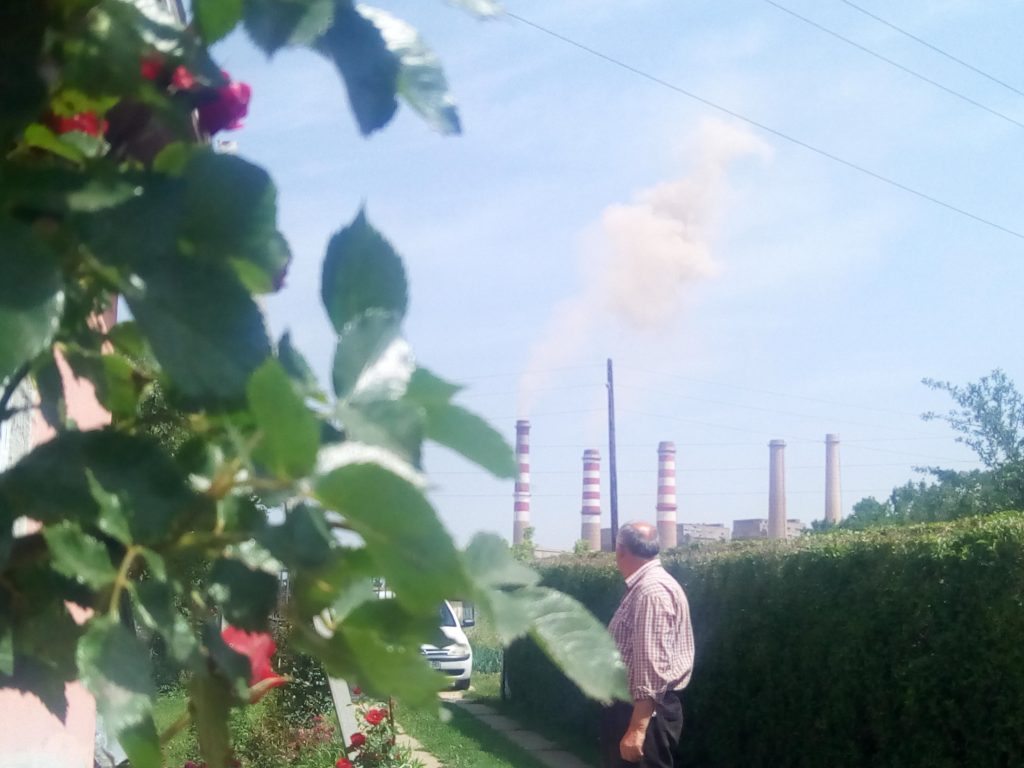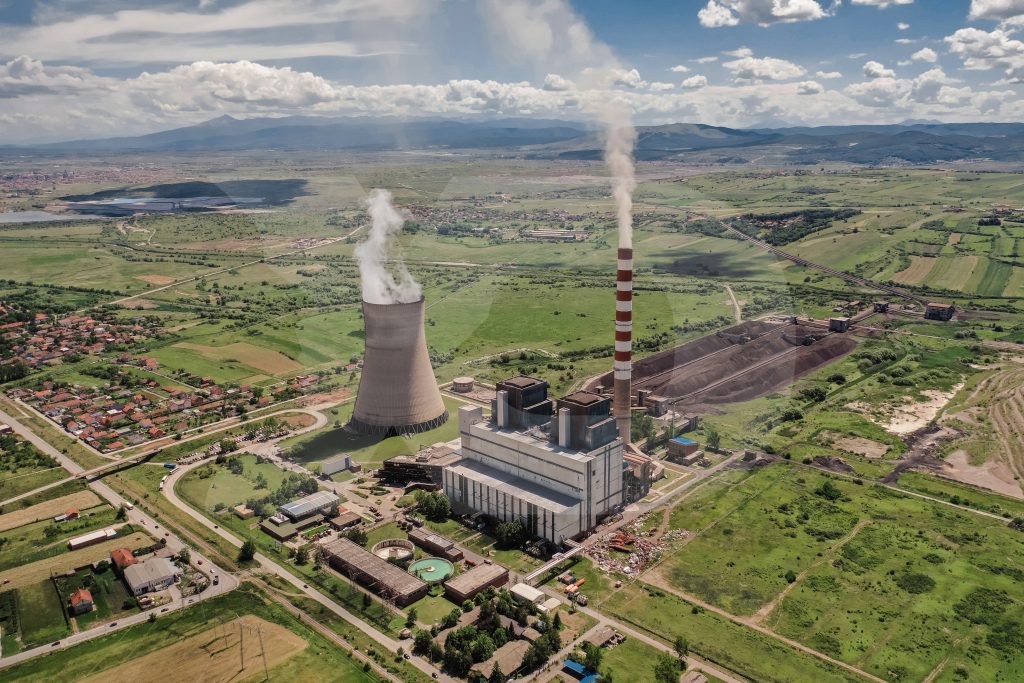

Stuck between the KEK power plant and its landfill, Dardhishte residents suffer daily from the biggest polluter in Kosovo, and institutions are not heeding their requests for relocation.
Gazmend Maxhuni, a resident of the Dardhishte village, had his hopes raised after recent discussions on air pollution. For years now he and his fellow villagers have been facing the problem of air pollution alone living alongside Kosova A power plant, one of the biggest polluters in Kosovo.
Dardhishte is located between the power plant and the landfill. In the past, the ashen hill was barren and the winds blew the remains onto the village. The air was also contaminated as the ash was carried from the power plant to the landfill, the route traversing the village.
The troubles with the ash have overshadowed the damage done by the Kosova A power plant chimneys, which had no filters until 2012 when Kosovo Energy Corporation, KEK, invested 25 million euros to install them.
As Maxhuni talks about the difficulties of living under a chimney, one of Kosova A’s chimneys starts to spew black smoke, interrupting him mid-sentence.
“Look how they open the filters. This is how colossal environmental pollution happens. Where kids, plants, animals feed on the land,” said Maxhuni concerned.
One can see the black smoke with the naked eye, and there are photographs to prove it as well. Residents claim black smoke comes out every night, but KEK denies that this is a regular occurrence, saying that black smoke comes out of the chimneys only in rare occasions.
Skender Bucolli, KEK spokesperson, said that black smoke is released only in extraordinary circumstances.
“As for the black smoke, this can happen only in extraordinary cases when we start up the power plant units, which are started up with oils, and until it is synchronized, which can last a maximum three or four hours, technically it’s impossible to make the electro-filters functional,” declared Bucolli. During the summer, Bucolli explained, KEK had to shut down unit 83 because its electro-filter did not function. In Bucolli’s opinion, this shows that the KEK management is concerned about the environment.
The chimneys are not the Dardhishte residents’ only concern. Every day their windows and gardens are covered in ash, which is transported through their village to the landfill.
Ilir Morina, director of the Environmental Protection Agency, told BIRN that projects for recultivating ash and removing dangerous phenol matter, as well as the millions of euros spent to improve the environment, do not seem to be improving the situation.
He said that despite 50 million euros in investments, the pollution from the ash landfill continues. He said that different reports show that mining and the power plants around Obiliq are the main source of pollution in the Prishtina region.

Health concerns
Gazmend Maxhuni claimed to have the facts proving just how much damage KEK’s activity causes for public health. The entire village used to keep cattle, he explains, but as time passed they were too scared to consume the meat.
“The animals’ lungs turned black, and this was a sign that their meat may not be healthy. For this reason, over 95 per cent of the residents sold the cattle,” said Maxhuni.
Many villagers have died from cancer or other diseases caused by polluted air, said Maxhuni.
“Over 40 [extended] family members of mine have died. None older than 50,” he said, adding that the villagers’ biggest fear is that they will get cancer.
His neighbour, Isak Maxhuni, gave another example of pollution’s visibility–he referenced the roof tiles on the villages’ homes, which have turned gray.
“The roof tiles used to be red, but now they are gray and black. This dust impacts rocks and concrete; imagine what it can do to the human body,” said Isak. He said that he was forced to change the roof tiles because they were damaged to the point that they were no longer water resistant.
Atifete Shylemaja, director of the Family Medicine Centre in Obiliq, said that 109 new cases of cancerous diseases have been identified just in the past five years. She said that by the first part of 2016, four new cases of cancer and 230 pneumonia cases were identified.
According to Zeqir Veselaj, the area around the two Kosovo power plants has one of the highest levels of pollution in the country.
“KEK is one of the biggest active polluters, while before the [1999] war this position was held by Trepca with its production and mining capacities,” Veselaj wrote in a forthcoming monograph.
He argues that the impact of the mining and power plants, depending on the wind and its speed, can be noticed in Prishtina, Fushe Kosove, Vushtrri, Shtime and Lipjan.
Reality check
In October 2016, the high level of pollution in Prishtina became a matter of public discourse alarming the city-dwellers. Data issued by the US Environmental Protection Agency and measured at the US embassy in Prishtina revealed “unhealthy” and “hazardous” levels of pollution in the city.
However, KEK is not the only culprit in the air pollution because old cars are also considered as a great polluter in Kosovo. Households that warm their homes with coal are also polluters.
Skender Syla, the director of World Health Organisation, WHO, in Kosovo, said that around 2,000 early deaths are recorded in Kosovo every year. The lack of a clean environment contributes to these numbers, Syla said.
Kosovo Ombudsperson Hilmi Jashari has been paying close attention to environmental issues and has visited Obiliq frequently in an effort to monitor the conditions of residents living in close proximity to mines and the power plants.
“Obiliq, together with its surrounding villages, with its pollution 30 per cent higher than any other municipality, leads in malignant and respiratory diseases. This should be a state priority because the health of 20,000 residents is in question,” said Jashari.
In addition to Shipitull, Hade and Dardhishte, there’s another problem, explained the mayor Xhafer Gashi: the regional landfill in this area. According to him, this landfill poisons the residents daily.
The conditions of residents living next to the coal mine are a topic of discussion at the municipality of Obiliq. Arben Berisha, environment director, even admits that Dardhishte, Shipitull, Hade, and Obiliq are colloquially named as “the Death Places.” Unlike in Dardhishte, residents of Shipitull and Hade will be displaced and sent to a new location. However, the Inspection Panel of the World Bank has found irregularities and violations to the Bank’s own regulation in the displacement of these residents.
Despite the fact that it is located between the power plant and the mine, Dardhishte residents are not amongst those waiting to be dislocated. Gazmend Maxhuni, a Dardhishte local, nevertheless remains hopeful that the institutions will consider the difficult state of the air in this village, so that they too can be moved to another location.
“I don’t have the financial means to change my residence, so I’m forced to watch my children wake up every day and play in this contaminated environment. We live every day with the fear that we will get ‘the evil disease,’” said Maxhuni.
This article was produced as part of the Kosovo Fellowship for Quality Reporting, as part of the Media for All project implemented by Balkan Investigative Reporting Network and supported by the EU Office in Kosovo.
27 December 2016 - 15:44

A coalition of environmental organizations has enthusiastically welcom...

The opposition and the ruling party have exchanged barbs in parliament...

The smell is not the only problem caused by a lack of proper sewage sy...

Kosovo is facing crisis levels of air pollution and environmental degr...